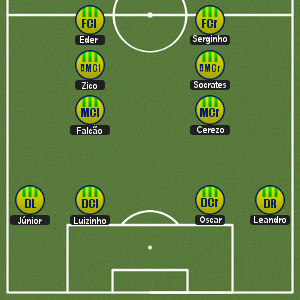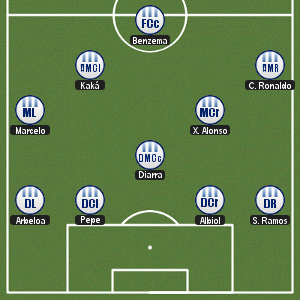This is the first in a series looking at real-world football tactics and how they might work in football manager. In each of these articles, we will look at a talking point in world football and then we will provide you with a tactic to download. For more discussion on real-world tactics and styles past and present, be sure to check out the appendix to Tactical Theorems ’10 which is still available to download from FM-Britain.
Real Madrid’s “magic box”
At the beginning of the season, Manuel Pellegrini, the Real Madrid head coach, had taken to playing a 4-4-2 “box” formation in order to accommodate the new arrivals in Perez’s Galacticos II. After some pretty shaky performances and wide-spread speculation that he was about to lose his job, he appears now to have settled on a version of 4-3-3. But why did he ditch the box? And what is he left with now?

The box midfield, perhaps best exemplified by Brazil’s 1982 World Cup side, appeared on the face of it to be the perfect solution to the problem – namely, how do you fit so many of the world’s most technically gifted (and, therefore, expensive) players into one side?
It allowed two out-and-out forwards as well as two creative attacking midfielders. Kaká and Cristiano Ronaldo could play deep with full freedom to work their magic, while Benzema and Raúl would be ahead of them ready to consume whatever balls the midfield could provide them with.
To support this, two more-defensive midfielders (Diarra and Alonso) could cover the back line, as well as providing supporting balls themselves. And width could be provided by the marauding wing backs, Arbeloa and Sergio Ramos.
Unfortunately, this sort of system is inherently unbalanced. Against smaller teams with little ambition to come forward, it has great potential. Essentially playing with four players who have no defensive responsibilities whatsoever, combined with a further four who are also encouraged to create, can provide plenty of attacking opportunities and overwhelm the opposition. The problem is, every decent opponent Real Madrid faced (AC Milan and Barcelona in particular) caused them problems. The lack of cover as well as support from out wide, combined with a natural rift between the defensive “team” and the attacking “team” left Madrid exposed.
The Solution
FM-Britain Tactical Think Tank member cagiva has posted the solution that Pellegrini found. He can still harness the attacking skills of his galactico squad, but provides a far more equal player distribution, both horizontally and vertically.

By essentially turning the box 45 degrees, the system automatically gets more width and more depth. The two main goal scoring forwards, instead of playing FC-FC now play FC-AMR. The creativity now comes from AMC and MC. And the support players play at ML and DMC.
The result is more 4-3-3 than 4-2-4. It offers far more stability. But more importantly it is winning games.
The system in Football Manager
In shape, the new system is essentially the asymmetrical 4-2-3-1. Perhaps it is no coincidence that this was essentially the shape employed by Manchester United when Cristiano Ronaldo played there. To exploit his strengths, the AMR plays as an inside forward. This allows him to attack from the wing, cutting in and causing far more damage than he could by starting in the centre. His strike partner (FC) is more of a poacher, looking to make a yard for himself so he can slot the ball home. Behind him sits the other attacker at AMC, playing as an attacking midfielder and using his creativity to create openings.
Behind them lie the three main midfielders. The ML acts as a support player to those ahead of him, and so too does the creative MC deep-lying playmaker. The DMC is there to cover the defence and add solidity to the formation, playing as he does as a defensive midfielder.
Being asymmetrical, the manager will have to keep an eye on things such as marking and opposition instructions. This formation’s shape is unlikely to match the opposition’s, so you will need to make sure that you are not leaving players unmarked in space. It may also be necessary to force the side to put pressure on the opposition, particularly in their midfield.
It is also a system built around fluidity of movement in the front three. The technical skills of Kaká and Ronaldo especially are the fundamental reasons for the system’s success. Therefore, playing with low quality players who are uncomfortable with the ball at their feet is probably ill advised. You could probably get away with less physical strength (such as with a squad like Arsenal’s), but technical skill is essential.
The Download
If you would like to play with this style of football, then check out the downloadable tactic here from FM-Britain. This is a recreation of Pellegrini’s current style, with thanks to cagiva, a member of the Tactical Think Tank. You can find more tactics and discussion like this one in the TT Research Forum.
Download Pellegrini’s 4-3-3 tactic
Debate Pellegrini’s 4-3-3 tactic

An errattum, now fixed: I incorrectly mentioned that Heinze played at left back. Any fule no it’s no Arbeloa that plays at left back. My apologies!